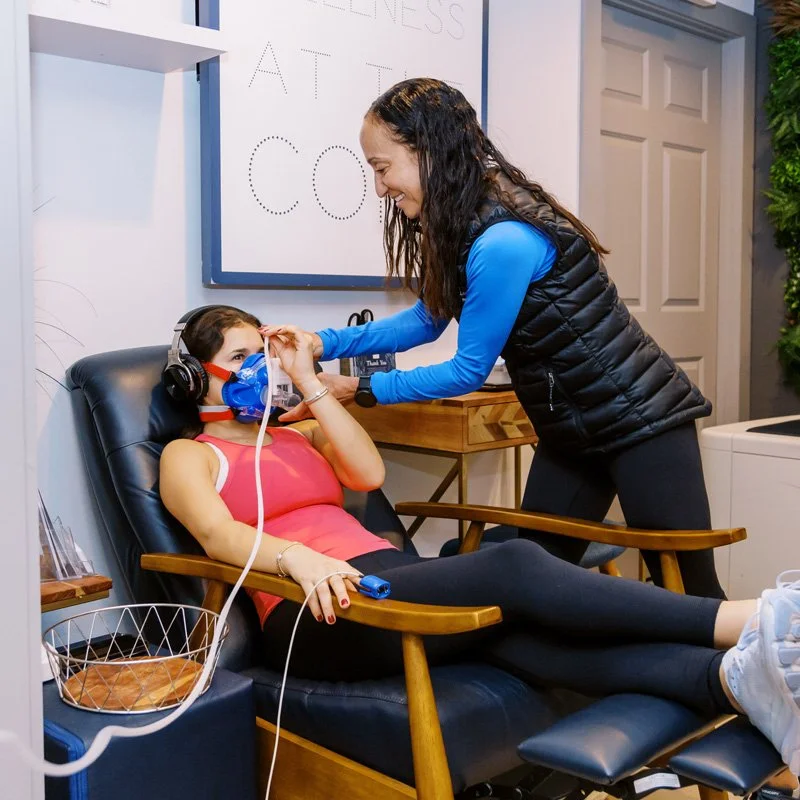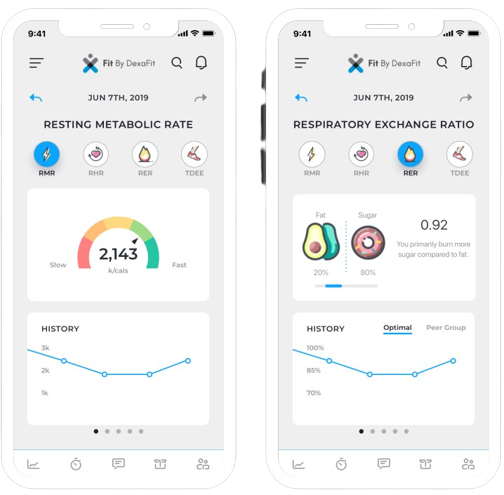Resting Metabolic Rate
Resting Metabolic Rate Testing in Westport, CT
Find the precise number of calories you burn at rest so you can reach your fitness goals based on your activity level, whether it be burning fat or building muscle.
Your resting metabolic rate (RMR) tells you exactly how much fuel your body needs at rest and whether you tend to burn fat or carbohydrates, making it the foundation of effective nutrition, training, and overall metabolic health. At Longevity Westport, our clinician-guided breathing test is quick and comfortable, and you leave with clear numbers and a simple plan, including daily calorie targets.
Why Your RMR Number Matters
Your RMR is the baseline behind sustainable nutrition and real results.
Your RMR accounts for the majority of calories you burn each day and is the foundation of an effective plan. Knowing it lets you:
Set precise calorie targets for fat loss, performance, or maintenance
Identify a slowed metabolism behind weight-loss stalls or low energy
Protect lean mass while reducing body fat
Align macros and meal timing with your body’s actual needs
What Happens During an RMR Test
Here’s what to expect from your RMR session at Longevity Westport.
Your RMR test takes place in a quiet, comfortable room where you’ll sit or recline and breathe normally through a soft mask or mouthpiece while the device measures your oxygen consumption. The session typically lasts 15 minutes, requires no exertion, and is completely non-invasive.
After the test, we review your results together and translate them into a simple plan: your daily calorie target, fuel utilization (fat vs. carbohydrate at rest), and a personalized plan for optimal health and nutrition.
Learn more about RMR
-
Resting Metabolic Rate (RMR) differs among individuals, reflecting the unique energy needs for fundamental bodily functions like breathing, blood circulation, and temperature maintenance. Influenced by factors such as age, gender, weight, activity level, and genetics, everyone's RMR is distinct.
Age contributes significantly, as metabolism tends to slow with age, resulting in a decrease in RMR. Gender also plays a role, with men generally having a higher RMR due to greater lean muscle mass.
Weight and activity level further impact RMR, with increased weight raising it and higher activity levels potentially decreasing it. Genetic traits can also influence RMR, contributing to individual variations. Recognizing that there is no one-size-fits-all approach, understanding your unique RMR is crucial for tailoring effective health and fitness strategies aligned with your specific needs and characteristics.
-
Several factors impact an individual's Resting Metabolic Rate (RMR). Age is a significant contributor, with metabolism naturally slowing down as one ages, leading to a reduced RMR.
Gender is another determinant, as men generally possess higher RMRs due to increased muscle mass. Body composition is crucial; individuals with more muscle typically exhibit a higher RMR, given that muscle requires more energy than fat.
Activity level and body temperature are additional influencers of RMR. Regular exercise tends to elevate RMR due to increased muscle mass, while higher body temperatures prompt the body to burn more calories.
Dietary habits and hormonal levels also play roles in RMR. A balanced diet, rich in protein and healthy fats, supports metabolic processes, while certain hormonal imbalances can slow down metabolism, resulting in a lower RMR. Understanding these multifaceted factors helps tailor strategies for optimizing RMR in alignment with individual health and fitness goals.
-
Recognizing your Resting Metabolic Rate (RMR) is pivotal for holistic health and well-being. This key metric informs the development of realistic weight loss or maintenance plans and ensures proper caloric intake.
By understanding how much energy your body requires at rest, you can make informed dietary choices tailored to your specific needs, avoiding overconsumption or inadequate nutrition.
Moreover, your RMR guides the planning of an exercise routine, providing insights into your available energy for physical activity and helping you choose the most suitable exercises for your body.
Additionally, monitoring changes in your RMR over time aids in adapting to shifts in age or lifestyle. As these factors evolve, so might your RMR, prompting adjustments in diet and exercise.
This knowledge empowers you to proactively manage your health, fostering informed decisions about nutrition and exercise that align with your body's unique requirements. Understanding your RMR is an integral component of taking control of your well-being and crafting a personalized plan for optimal health and nutrition.
-
By increasing your RMR, your body will be able to naturally burn more calories throughout the day. As with most aspects of your health, diet and exercise are important factors that contribute to your RMR.
Interval Training
Interval training is an excellent way to increase your resting metabolic rate over a 24 hour period. If you do one exercise for a long period of time, like biking or running, your body will get used to the motion and eventually burn less energy as the exercise goes on.
But if you switch between different types of workouts, your body won’t have the chance to get used to it. As a result, your body will continuously burn peak calories throughout the duration of that series of workouts.
So you might be wondering: does regular exercise speed up metabolism at rest?
Well, if you’re doing a consistent workout for long periods of time but your metabolic rate isn’t where you’d like it to be, try mixing up your routine with interval training to increase your RMR results!
Dietary Tips
In addition to building muscle mass and interval training, your diet patterns can also affect your RMR. Here’s a couple of tips dietitians recommend to help increase your RMR:
Eat a healthy breakfast
When you sleep, your RMR and metabolism slow down. Eating breakfast switches your metabolism back on, and therefore begins burning calories at a faster rate.
Eat more protein
Food that’s high in protein is usually low in calories and fat.
Plant-based proteins like tofu, quinoa, black beans, and tempeh are especially effective.
When you increase your protein intake, your body needs to work harder to break them down compared to fats and carbohydrates. As a result, your RMR will also increase.
-
A common question people have is what’s the difference between resting metabolic rate and basal metabolic rate, or RMR and BMR.
Often, these terms are used interchangeably. However, there is a difference.
BMR is the minimum number or calories required for basic functions at rest. Basic essential functions include: pumping blood throughout the body, breathing, digestion, keeping your body temperature stable, etc.
RMR is the number of calories that your body burns while it's at rest. In addition to the essential functions listed above for BMR, RMR accounts for additional low-effort activities. These activities include: eating, using the bathroom, walking for short periods, sweating or shivering, and consuming caffeine.
Your BMR is usually slightly lower (by about 10%) than your RMR since BMR is only accounting for basic essential functions. However, your BMR is almost impossible to measure accurately.
Therefore, measuring your RMR is a better number to reference than BMR because it more accurately represents the calories you burn per day.
Longevity Westport Serves Clients Across Fairfield County
Longevity Westport proudly serves clients across Fairfield County, including Westport, Wilton, Fairfield, Weston, Norwalk, Greenwich, Stamford, and surrounding communities, including Westchester County. Our local expertise, clinical precision, and personalized results can help you train with purpose and optimize your long-term health.





